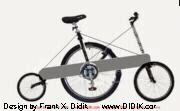|
The
Quest for the worlds lightest bicycle
The
under 4 lbs (1818 gram) bicycle
By Frank X. Didik
September 16, 2006
Purpose: The goal of this design construction project
was to create the lightest practical bicycle. The lighter the
bicycle, the easier, it is to operate and potentially the faster and
farther to travel, in a given time period.
Issues: The major issues in designing a super light
weight bike is the weight of the wheels, tires, drive components
(crank, pulley's, drive belts or chains or drive shaft), and the
wight of the frame. In addition, the craftsmanship and engineering in
key areas are essential to minimize energy loss do to friction and
excess wight. These include the machining of the wheel bearings, the
minimal wight of the frame and the choice of ultra strong but
non-conflicting materials. After studying a number of existing light
weight bicycles, I noticed that some of the bicycles used expensive
lightweight materials, such as carbon fiber, which, under certain
circumstances, can be made very strong, but because of the way that
these bicycles were constructed, the designs did not take advantage
of the unique properties of carbon fiber. Thus in some cases, excess
carbon fiber material was used, and in other cases, not all the
potential stresses were considered and the bicycle had the potential
for catastrophic failure of the carbon fiber. In other cases, I
noticed that the bicycles used mixed metals, such as steel and
aluminum. Such use of mixed metals can create galvanic reaction or
battery effect with the intersection area of the two metals gradually
being compromised do to rapid corrosion. It is interesting to note
that I have also observed the same flaw in a very expensive Italian
automobile design. Had the company taken precautions to shield the
mixed metal body, the sports car would not have been prone to such
rapid rusting. The stress and strain on the crankshaft and the frame,
is enormous and these components must be strong enough to endure high
loads, hour after hour.
Solution: Unfortunately, the solution to the issues
outlined above is not simple. Extremely or ultra light weight
materials capable of enduring the huge physical forces either do not
exist today or can not be readily engineered into a structurally
sound bicycle light enough to achieve and break the 1818 gram / 4lbs
weight goal. One method employed, that was not completely
satisfactory, was to form the frame out of lightweight Styrofoam,
with a thin hollow steel (yes steel) rod in the center. The Styrofoam
itself was covered with a thin layer of carbon fiber material. This
created an incredibly light "frame". The steel rod served
several purposes including to provide a certain degree of stability,
to maintain shape in case the carbon fiber - Styrofoam frame failed
and equally as important, to serve to hold the wheel bearing housing
and to provide and anchorage point for the necessary piano wire
stress and strain cables, which stabilize the frame to the steering
column and seat column. In the photographs above, the bicycle to the
left was lighter than the bicycle to the right, however it was found
to be very unstable and ran a constant risk of falling backwards. To
alleviate this, the bicycle to the right was designed to have a
non-drive small rear free turning wheel. I suppose under strict
definition, this should be referred to as a tricycle variant. The
free turning rear wheel solved the instability and in fact made the
"bicycle" feel substantially stronger. The wheels were
stripped down to a level of just adequate, with the tires glued on to
a "rimless" rim.
Additional Design Information Available A fair amount
of unique information was gathered through careful design, testing
and trial and error and many existing mistakes and flaws were
uncovered during this process. If you are a manufacturer of bicycles,
motorcycles or specialty cars, you may wish to contact this designer.
The author of this article can be
reached by email at "bicycle at didik.com".
To control spam, which recently has reached the level of thousands
per week, please summarize the purpose of the email, in the heading
such as "bicycle design" or "cycle engineering"
or "can you help with our bicycle design". Thank you. |
Other
pages on DIDIK.com covering alternate
energy vehicles:

This "1818" bicycle design was found to be
lighter, but had major instability problems including the potential
to fall backwards. The piano wire served to stiffen the structure.

The above "1818" bicycle could in fact be
considered a hybrid tricycle since it incorporates a small free
turning wheel in the rear. This bicycle arrangement, though heavier
than above, proved to be substantially better in several ways
including stability and strength. |